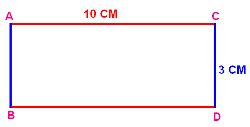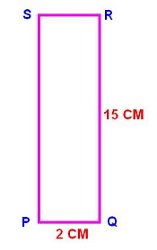Before you read this article you must know,
What is Perimeter
Perimeter of Rectangle is to sum of length of all its four sides
And we know that in rectangle opposite sides are equal, so we get;
Perimeter of Rectangle = Length + Length + Breadth + Breadth
P = 2 Length + 2 Breadth
P = 2 (Length + Breadth)
P = 2 (L + B)
Example 1 - In the following Rectangle ABCD;

Perimeter of Rectangle ABCD = 2 (L + B)
P = 2 (10 + 3)
P = 2 X 13
P = 26 cm
Example 2 - In the following Rectangle PQRS

Perimeter of Rectangle PQRS = 2 (L + B)
P = 2 (15 + 2)
P = 2 X 17
P = 34 cm
|






